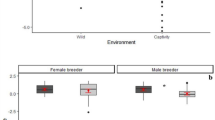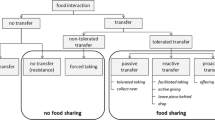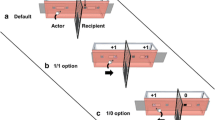Abstract
Social facilitation of eating familiar foods might serve to synchronize eating activities within groups. We aimed to assess whether capuchins (Cebus apella) are prompted to eat when observing other conspecifics eating a familiar food. Subjects were 8 male captive-born tufted capuchins. One pair of capuchins acted as demonstrators for the other 6 observer subjects. In the Experimental condition, the demonstrator pair was given fresh chow in addition to having access to the leftover food and ate continuously. In the Control condition, the demonstrator pair had access to food leftover from the morning feed and ate very little. The initiation of feeding by the demonstrator pair prompted the initiation of feeding behavior in the observers, and the latter ate significantly more of their leftovers in the Experimental than in the Control condition. The tempo ofthe social facilitation of eating familiar foods in capuchins supportisomorphic coordination, a process that occurs when one individual’s activity focuses the attention of another individual to the same activity, thereby increasing behavioral similarity in a group.
Similar content being viewed by others
References
Addessi, E., and Visalberghi, E. (2001). Social facilitation of eating novel foods in tufted capuchin monkeys (Cebus apella): Input provided, responses affected and cognitive implications. Anim. Cogn. 4: 297–303.
Boinski, S. (1987). Birth synchrony in squirrel monkeys (Saimiri oerstedii): A strategy to reduce neonatal predation. Behav. Ecol. 21: 393–400.
Brown, C., and Laland, K. N. (2002). Social learning of a novel avoidance task in the guppy: Conformity and social release. Anim. Behav. 64: 41–47.
Clayton, D. A. (1978). Socially facilitated behavior. Q. Rev. Biol. 53: 373–392.
Clenenden, V. I., Herman, P. C., and Polivy, J. (1994). Social facilitation of eating among friends and strangers. Appetite 23: 1–13.
Coussi-Korbel, S., and Fragaszy, D. (1995). On the relation between social dynamics and social learning. Anim. Behav. 50: 1441–1453.
Crook, J. H. (1961). The basis of flock organization in birds. In Thorpe, W. H., andZangwill, O. L. (eds.), Current Problems in Animal Behaviour, Cambridge University Press, Cambridge, pp. 125–149.
Day, R. L., MacDonald, T., Brown, C., Laland, K. N., and Reader, S. M. (2001). Interactions between shoal size and conformity in guppy social foraging. Anim. Behav. 62: 917–925.
de Castro, J. M. (1991). Social facilitation of the spontaneous meal size of humans occurs on both weekdays and weekends. Physiol. Behav. 49: 1289–1291.
Emlen, S. T., and Demong, N. J. (1975). Adaptive significance of synchronized breeding in a colonial bird: A new hypothesis. Science 188: 1029–1031.
Ferrari, P. F., Gallese, V., Rizzolatti, G., and Fogassi, L. (2003). Mirror neurons responding to the observation of ingestive and communicative mouth actions in the monkey ventral premotor cortex. Eur. J. Neurol. 17: 1703–1714.
Galef, B. G. Jr., and Giraldeau, L. A. (2001). Social influences on foraging in vertebrates: Causal mechanisms and adaptive functions. Anim. Behav. 61: 3–15
Harlow, H. F., and Yudin, H. C. (1933). Social behavior of primates. J. Comp. Psychol. 16: 171–185.
Hsia, L. C., and Wood-Gush, D. G. M. (1984). Social facilitation in the feeding behavior of pigs and the effect of rank. Appl. Anim. Ethol. 11: 265–270.
Izawa, K. (1980). Social behavior of the wild black-capped capuchin (Cebus apella). Primates 21: 443–467.
Janson, C. H. (1996). Toward an experimental socioecology of primates: Examples from Argentine brown capuchin monkeys (Cebus apella nigrivittatus). In Norconk, M., Garber, P., and Rosenberger, A. (eds.), Adaptive Radiations of Neotropical Primates, Plenum Press, New York.
Keeling, L. J., and Hurnik, J. F. (1993). Chickens show socially facilitated feeding behavior in response to a video image of a conspecific. Appl. Anim. Behav. Sci. 36: 223–231.
Kinzey, W. G. (1997). New World Primates: Ecology, Evolution and Behavior. Aldine, Hawthorne, NY.
Krebs, J. R. (1974). Colonial nesting and social feeding as strategies for exploiting food resources in the great blue heron (Ardea herodias). Behaviour 51: 99–130.
Kummer, H. (1971). Primate Societies, Harlan Davidson, Arlington Heights, IL.
Lachlan, R. F., Crooks, L., and Laland, K. N. (1998). Who follows whom? Shoaling preferences and social learning of foraging information in guppies. Anim. Behav. 56: 181–190.
Laland, K. N., and Williams, K. (1997). Shoaling generates social learning of foraging information in guppies. Anim. Behav. 53: 1161–1169.
Mason, R. J., and Reidinger, R. F. (1981). Effects of social facilitation and observational learning on feeding behavior of the red-winged blackbird (Agelaius phoeniceus). Auk. 98: 778–784.
Nishida, T. (1987). Local traditions and cultural transmission. In Smuts, B., Cheney, D., Seyfarth, R., Wrangham, R., and Struhsaker, T. (eds.), Primate Societies, University of Chicago Press, Chicago, pp. 462–474.
Perry, S., and Rose, L. (1994). Begging and transfer for coati meat by white-faced capuchin monkeys, Cebus capucinus. Primates 35: 409–415.
Pitcher, T. J., and Parrish, J. K. (1993). Functions of shoaling behaviour in telosts. In Pitcher, T. J. (ed.), The Behavior of Teleost Fishes, 2nd edn. Chapman & Hall, London, pp. 363–440.
Reader, S. M., Kendal, J. R., and Laland, K. N. (2003). Social learning of foraging sites and escape routes in wild Trinidadian guppies. Anim. Behav. 66: 729–739.
Redd, M., and de Castro, J. M. (1992). Social facilitation of eating: Effects of social instruction on food intake. Physiol. Behav. 52: 749–754.
Rizzolatti, G., Fadiga, L., Fogassi, L., and Gallese, V. (1999). Resonance behaviors and mirror neurons. Archives italiennes de biologie 137: 85–100.
Rizzolatti, G., Fadiga, L., Gallese, V., and Fogassi, L. (1996). Premotor cortex and the recognition of motor actions. Cognitive Brain Res. 3: 131–141.
Ross, S., and Ross G. W. (1949). Social facilitation of feeding behavior in dogs: II. Feeding after satiation. J. Genet. Psychol. 74: 293–304.
Snowdon, C. T., and Boe, C. Y. (2003). Social communication about unpalatable foods in tamarins. J. Comp. Psychol. 117: 142–148.
Visalberghi, E., and Addessi, E. (2000). Seeing group members eating a familiar food enhances the acceptance of novel foods in capuchin monkeys. Anim. Behav. 60: 69–76.
Visalberghi, E., and Addessi, E. (2001). Acceptance of novel foods in Cebus apella: Do specific social facilitation and visual stimulus enhancement play a role? Anim. Behav. 62: 567–576.
Visalberghi, E., and Addessi, E. (2003). Food for thoughts: Social learning and the feeding behavior in capuchin monkeys. Insights from the laboratory. In Fragaszy, D., and Perry, S. (eds.), Traditions in Non-human Animals: Models and Evidence. Cambridge University Press, Cambridge.
Visalberghi, E., and Fragaszy, D. (1995). The behaviour of capuchin monkeys, Cebus apella, with novel foods: The role of social context. Anim. Behav. 49: 1089–1095.
Ward, P., and Zahavi, A. (1973). The importance of certain assemblages of birds as “information centers” for food-finding. Ibis 115: 517–534.
Author information
Authors and Affiliations
Corresponding author
Rights and permissions
About this article
Cite this article
Galloway, A.T., Addessi, E., Fragaszy, D.M. et al. Social Facilitation of Eating Familiar Food in Tufted Capuchins (Cebus apella): Does it Involve Behavioral Coordination?. Int J Primatol 26, 181–189 (2005). https://doi.org/10.1007/s10764-005-0729-7
Received:
Revised:
Accepted:
Issue Date:
DOI: https://doi.org/10.1007/s10764-005-0729-7




